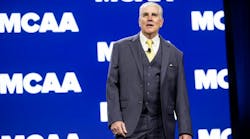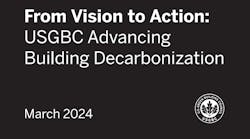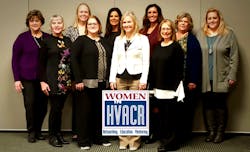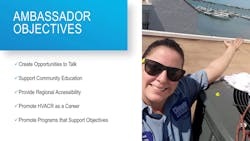With so few female role models, it’s understandable that many women who make the decision to enter the heating, ventilation, air conditioning and refrigeration industry believe they have to go it alone — women comprise less than 10 percent of the entire construction workforce, 7 percent in engineering and 2 to 5 percent in the specialty trades.
But groups such as Women in HVACR (WHVACR) are trying to change those stats. WHVACR is a nonprofit organization dedicated to improving the lives of its members by empowering women to succeed through networking, mentoring and education.
“This organization came about because more than 15 years ago, a group of us realized there were very few women in the industry,” explains Marcia Christiansen, the group’s secretary and national sales manager at Portland, OR-based PECO. “The total number of women in HVACR today is low — quoted at 4 percent. Most women do not even recognize HVACR as a career option.”
The 2019 board members of Women in HVACR (left to right): Marcia Christiansen, secretary; Renee Joseph; Lauren Roberts; Karen Lamy DeSousa, vice president; Denise Tudor; Danielle Putnam, president; Angie Snow, treasurer; Susan Archer; Mary Jo Gentry, immediate past president; and Colleen Keyworth. Not pictured are Colleen Leppert and Jennie Bryan (Photo courtesy of Women in HVACR).
The group started out as an avenue for women in the mechanical contracting field to meet. Membership was then expanded to those women in HVACR manufacturing, distribution, service providers and engineers/designers — the whole spectrum of the supply chain.
About 10 percent of WHVACR’s membership is in the engineering/design field, although Christiansen says it’s hard to come up with an actual number. “Many women members fill multifunctional roles in the industry that include technical design and marketing specification applications,” she explains. “We have a number of very talented people who routinely specify and engineer systems and components.”
For members such as Colleen Keyworth, sales and training coordinator at Contractor’s Online Access and the marketing manager for WHVACR, networking with other women in the mechanical industry is worth the price of admission.
Women in HVACR’s Ambassador Program encourages members to visit schools and groups in their local areas to promote HVACR careers. Communities can also put in a request for a member to visit or participate in an event (Source: “Getting the Most Out of My Membership,” Women in HVACR).
“I didn’t start out in the industry; I was a wedding planner then moved into marketing,” she notes. “For me, WHVACR has been a huge advantage. The number of networking opportunities and events I’ve been to, the people I’ve met through them and the business opportunities have been limitless.”
Christiansen adds: “We offer our members a national network of women in the industry. This means that when you go to a trade show, such as AHR, you have a group of friends already in place. We normally have a meet and greet, booth or other events to connect up and share.”
Mentoring Members
WHVACR believes that mentorship is important for its members. The group defines a mentor as “an experienced professional who offers career guidance, advice and assistance. Someone who has been where you are and can offer a ‘been there, done that’ perspective to help you avoid pitfalls and reinventing the wheel. [A mentor] can help you set and achieve career goals, make smarter business decisions, overcome workplace challenges, learn new skills or simply offer an unbiased third-party perspective when you’re facing frustrations at work.”
Keyworth says: “Our mentorship program is very popular. It connects people from across the United States and Canada with other people who are like them or who may be in different stages of their professional careers. It allows women to help others in the HVACR industry.”
The program sets guidelines for the mentor/mentee to ensure a beneficial relationship for both. These include setting up an introductory phone call, followed by an in-person meeting. WHVACR suggests meeting online or in person every other month for one to two hours. These meetings should be considered confidential.
Women are a largely untapped resource to fill vacant HVACR jobs as engineers, technicians, sales and management (Source: “Getting the Most Out of My Membership,” Women in HVACR).
Topics can range from breaking through barriers in the HVACR industry to managing conflict in the work environment to tips and strategies to achieve work/life balance to workforce development. These resources can be found on WHVACR’s website, www.womeninhvacr.org. Members also connect via Facebook and LinkedIn.
Keyworth is quick to point out that the group is not exclusive to women; it does have a few male members. But the focus is on women because they have different experiences and problems in the HVACR industry that men don’t. Women think differently, they solve problems differently and are more collaborative, she says.
The experiences women have in the traditionally male-dominated industry of HVACR are as varied as the women themselves. Some have found acceptance of their role in the industry while others can identify with the #MeToo movement. The support of other women can be crucial to finding solutions to workplace challenges men do not have to deal with.
One concern many women in the HVACR industry have is balancing their work lives with their family lives.
Industry networking and education are important aspects of Women in HVACR membership. The organization plans meet-and-greets at industry conventions and trade shows, as well as setting up a booth to promote HVACR careers. It also holds an annual convention for members, which will held in Boston next fall.
“What do you do between raising a family and getting a job?” Keyworth notes. “What’s the retention rate of women in the industry? That’s a big topic on the table right now. Women want to climb the corporate ladder but they also want to start a family. But because they go on maternity leave, or have different schedule conflicts or can’t travel as much, women are being forced to choose between whether they can raise a family or go for the full promotion. Men usually aren’t forced to make that same decision.”
Inspiring the Next Generation
A large focus of WHVACR is making people aware of the career opportunities in the HVACR industry — men and women. “There is a deficit for trades jobs in this country and it seems as if no one talks about it outside of the industry,” Keyworth notes. “We want the next generation to understand that the HVACR industry can provide them a good living.”
WHVACR members speak at their local schools or other groups such as the Girl Scouts or STEM meetups to promote HVACR careers at all levels. This Ambassador Program was developed to help generate awareness of lucrative opportunities in the HVACR industry.
The organization offers multiple $2,000 scholarships to females interested in entering the HVACR industry through a technical or trade school or who want to pursue a bachelor’s degree in a four-year college. Applications and essays for 2019 awards are due June 1, 2019.
WHVACR also offers free membership for students enrolled in a trade/technical school or college pursuing a career in engineering or other HVACR trade.
Educational opportunities for members can be found at industry conferences and trade shows, such as the AHR Expo. WHVACR usually has a booth and a meet-and-greet scheduled for members there. The group also has a monthly “Zoom-In” conference call with technical and soft-skills training.
And, of course, there is WHVACR’s annual conference, which this year will be in Boston, Sept. 25-27.
Keyworth’s advice to women interested in an HVACR career? “Find somebody that you can connect with,” she says. “Find somebody you can walk into a room with. Listen and learn.”













